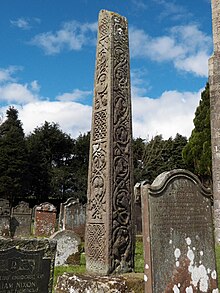Bewcastle Cross
The cross shaft of Bewcastle ( English Bewcastle Cross ) is the residue of an Anglo-Saxon cross; which stands in situ in the churchyard of St Cuthbert's Church in Bewcastle , Cumbria , England .
The cross, probably from the 7th or early 8th century, has reliefs and runic inscriptions. The head of the cross is missing. The almost square shaft is about 4.4 meters high and measures 56 × 54 cm at the base. The Bewcastle Cross is similar in many respects to the Ruthwell Cross , although the inscriptions are simpler and appear to have a memory function. The crosses of Bewcastle and Ruthwell were described by the German-British art historian Nikolaus Pevsner (1902–1983 - pseudonym Peter FR Donner ) as "the greatest achievement of their time in all of Europe". They are the most elaborately decorated Anglo-Saxon crosses that have largely been preserved intact. The dating remains controversial, although Éamonn Ó Carragaáin writes in 2007: “Although there is discussion about the dates of the crosses, there is a growing consensus that both go to the first half of the 8th century in the age of Beda Venerabilis (who died in 735) or can be dated to the generation after his death. "
There were suggestions that none of the crosses were an individual work. The theory that the cross is likely the work of the team of sculptors led by Benedikt Biscop (AD 628–690) reflects the dating of scholars such as the art historian Meyer Schapiro (1904–1996).
Literature and Sources
- Beda Venerabilis : Historia ecclesiastica gentis Anglorum , Online in the Medieval Sourcebook (English)
Web links
Coordinates: 55 ° 3 ′ 48.7 " N , 2 ° 40 ′ 55.4" W.

